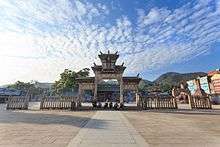Chinese gods and immortals
Chinese traditional religion is polytheistic; many deities are worshipped in a pantheistic view where divinity is inherent in the world.[1] The gods are energies or principles revealing, imitating and propagating the way of Heaven (Tian 天), which is the supreme godhead manifesting in the northern culmen of the starry vault of the skies and its order. Many gods are ancestors or men who became deities for their heavenly achievements; most gods are also identified with stars and constellations.[2] Ancestors are regarded as the equivalent of Heaven within human society,[3] and therefore as the means connecting back to Heaven, which is the "utmost ancestral father" (曾祖父 zēngzǔfù).[4]
| Part of a series on |
| Chinese folk religion |
|---|
 |
|
Theory
Model humanity: |
|
Institutions and temples |
|
Internal traditions Major cultural forms
Main philosophical traditions: Ritual traditions: Devotional traditions: Zhenkong, "Void of Truth". Confucian churches and sects:
|
|
Related religions
|
Gods are innumerable, as every phenomenon has or is one or more gods, and they are organised in a complex celestial hierarchy.[5] Besides the traditional worship of these entities, Confucianism, Taoism and formal thinkers in general give theological interpretations affirming a monistic essence of divinity.[6] "Polytheism" and "monotheism" are categories derived from Western religion and do not fit Chinese religion, which has never conceived the two things as opposites.[7] Since all gods are considered manifestations of 氣 qì, the "power" or pneuma of Heaven, some scholars have employed the term "polypneumatism" or "(poly)pneumatolatry", first coined by Walter Medhurst (1796–1857), to describe the practice of Chinese polytheism.[8] In the theology of the classic texts and Confucianism, "Heaven is the lord of the hundreds of deities".[9] Modern Confucian theology compares them to intelligence, substantial forms or entelechies (inner purposes) as explained by Leibniz, generating all types of beings, so that "even mountains and rivers are worshipped as something capable of enjoying sacrificial offerings".[10]
Unlike in Hinduism, the deification of historical persons and ancestors is not traditionally the duty of Confucians or Taoists. Rather depends on the choices of common people; persons are deified when they have made extraordinary deeds and have left an efficacious legacy. Yet, Confucians and Taoists traditionally may demand that state honour be granted to a particular deity. Each deity has a cult centre and ancestral temple where he or she, or the parents, lived their mortal life. There are frequently disputes over which is the original place and source temple of the cult of a deity.[11]
Terminology
In Chinese language there is a terminological distinction between 神 shén, 帝 dì and 仙 xiān. Although the usage of the former two is sometimes blurred, it corresponds to the distinction in Western cultures between "god" and "deity", Latin genius (meaning a generative principle, "spirit") and deus or 'Deva' ( sanskrit ) and 'divus; dì, sometimes translated as "thearch", implies a manifested or incarnate "godly" power.[note 1][13] It is etymologically and figuratively analogous to the concept of di as the base of a fruit, which falls and produces other fruits. This analogy is attested in the Shuowen Jiezi explaining "deity" as "what faces the base of a melon fruit".[14] The latter term 仙 xiān unambiguously means a man who has reached immortality, ( Xian sounds similar to Sanskrit word Chiranjeevi, The Immortal one) similarly to the Western idea of "hero".[15]
God of Heaven
_in_%CE%B1_Ursae_Minoris%2C_drawing_a_w%C3%A0n_%E5%8D%8D_in_the_four_phases_of_time.svg.png)
Chinese traditional theology, which comes in different interpretations according to the classic texts, and specifically Confucian, Taoist and other philosophical formulations,[22] is fundamentally monistic, that is to say it sees the world and the gods who produce it as an organic whole, or cosmos.[23] The universal principle that gives origin to the world is conceived as transcendent and immanent to creation, at the same time.[24] The Chinese idea of the universal God is expressed in different ways; there are many names of God from the different sources of Chinese tradition.[15]
The radical Chinese terms for the universal God are Tiān 天 and Shàngdì 上帝 (the "Highest Deity") or simply Dì 帝 ("Deity").[25][26] There is also the concept of Tàidì 太帝 (the "Great Deity"). Dì is a title expressing dominance over the all-under-Heaven, that is all things generated by Heaven and ordered by its cycles and by the stars.[27] Tiān is usually translated as "Heaven", but by graphical etymology it means "Great One" and a number of scholars relate it to the same Dì through phonetic etymology and trace their common root, through their archaic forms respectively *Teeŋ and *Tees, to the symbols of the squared north celestial pole godhead (Dīng 口).[2][28] These names are combined in different ways in Chinese theological literature, often interchanged in the same paragraph if not in the same sentence.[29]
Names of the God of Heaven
Tian is known by many names. Besides Shangdi and Taidi, other names include Yudi ("Jade Deity"), and Taiyi ("Great Oneness") who, in mythical imagery, holds the ladle of the Big Dipper (Great Chariot) providing the movement of life to the world.[30] As the hub of the skies, the north celestial pole constellations are known, among various names, as Tiānmén 天門 ("Gate of Heaven")[19] and Tiānshū 天樞 ("Pivot of Heaven").[20]
Other names of the God of Heaven are attested in the vast Chinese religio-philosophical literary tradition:
- Tiāndì 天帝—the "Deity of Heaven" or "Emperor of Heaven":[31] "On Rectification" (Zheng lun) of the Xunzi uses this term to refer to the active God of Heaven setting in motion creation;[27]
- Tiānzhǔ 天主—the "Lord of Heaven": In "The Document of Offering Sacrifices to Heaven and Earth on the Mountain Tai" (Fengshan shu) of the Records of the Grand Historian it is used as the title of the first God from whom all the other gods derive.[32]
- Tiānhuáng 天皇—the "King of Heaven": In the "Poem of Fathoming Profundity" (Si'xuan fu), transcribed in "The History of the Later Han Dynasty" (Hou Han shu), Zhang Heng ornately writes: «I ask the superintendent of the Heavenly Gate to open the door and let me visit the King of Heaven at the Jade Palace»;[31]
- Tiāngōng 天公—the "Duke of Heaven" or "General of Heaven";[33]
- Tiānjūn 天君—the "Prince of Heaven" or "Lord of Heaven";[33]
- Tiānzūn 天尊—the "Heavenly Venerable", also a title for high gods in Taoist theologies;[31]
- Tiānshén 天神—the "God of Heaven", interpreted in the Shuowen Jiezi as "the being that gives birth to all things";[27]
- Shénhuáng 神皇—"God the King", attested in Taihong ("The Origin of Vital Breath");[27]
- Lǎotiānyé (老天爺)—the "Olden Heavenly Father".[31]
Tian is both transcendent and immanent, manifesting in the three forms of dominance, destiny and nature of things. In the Wujing yiyi (五經異義, "Different Meanings in the Five Classics"), Xu Shen explains that the designation of Heaven is quintuple:[32]
- Huáng Tiān 皇天 —"Yellow Heaven" or "Shining Heaven", when it is venerated as the lord of creation;
- Hào Tiān 昊天—"Vast Heaven", with regard to the vastness of its vital breath (qi);
- Mín Tiān 旻天—"Compassionate Heaven", for it hears and corresponds with justice to the all-under-Heaven;
- Shàng Tiān 上天—"Highest Heaven" or "First Heaven", for it is the primordial being supervising all-under-Heaven;
- Cāng Tiān 蒼天—"Deep-Green Heaven", for it being unfathomably deep.
All these designations reflect a hierarchical, multiperspective experience of divinity.[15]
Lists of gods, deities and immortals
Many classical books have lists and hierarchies of gods and immortals, among which the "Completed Record of Deities and Immortals" (神仙通鑑, Shénxiān Tōngjiàn) of the Ming dynasty,[34] and the Biographies of the Deities and Immortals or Shenxian Zhuan by Ge Hong (284-343).[35] There's also the older Collected Biographies of the Immortals or Liexian Zhuan. Couplets or polarities, such as Fuxi and Nuwa, Xiwangmu and Dongwanggong, and the highest couple of Heaven and Earth, all embody yin and yang and are at once the originators and maintainers of the ordering process of space and time.[36]
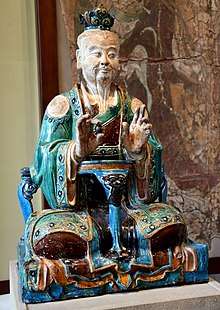
Cosmic gods
- Yudi (玉帝 "Jade Deity") or Yuhuang (玉皇 "Jade Emperor" or "Jade King"), is the popular human-like representation of the God of Heaven.[37] Jade traditionally represents purity, so it is a metaphor for the unfathomable source of creation.
- Doumu (斗母 "Mother of the Great Chariot"), often entitled with the honorific Tianhou (天后 "Queen of Heaven")[lower-roman 1] is the heavenly goddess portrayed as the mother of the Big Dipper (Great Chariot), whose seven stars in addition to two invisible ones are conceived as her sons, the Jiuhuangshen (九皇神 "Nine God-Kings"), themselves regarded as the ninefold manifestation of Jiuhuangdadi (九皇大帝, "Great Deity of the Nine Kings") or Doufu (斗父 "Father of the Great Chariot"), another name of the God of Heaven. She is therefore both wife and mother of the God of Heaven.[38][39]
- Pangu (盤古), a macranthropic metaphor of the cosmos. He separated yin and yang, creating the earth (murky yin) and the sky (clear yang). All things were made from his body after he died.[40]
- Xiwangmu (西王母 "Queen Mother of the West"),[lower-roman 2] identified with the Kunlun Mountain, shamanic inspiration, death and immortality.[42][43] She is the dark, chthonic goddess, pure yin, at the same time terrifying and benign, both creation and destruction, associated with the tiger and weaving.[44] Her male counterpart is Dongwanggong (東王公 "King Duke of the East";[lower-roman 3] also called Mugong, 木公 "Duke of the Woods"),[45] who represents the yang principle.[44]
- Yi the Archer (Hòuyì 后羿) was a man who sought for immortality reaching Xiwangmu on her mountain Kunlun.
- Yanwang (閻王 "Purgatory King")[lower-roman 4] the ruler of the underworld, assisted by the Heibai Wuchang (黑白無常 "Black and White Impermanence") representing the alternation of yin and yang principles, alongside Ox-Head and Horse-Face, who escort spirits to his realm.
- Yinyanggong (陰陽公 "Yinyang Duke"[lower-roman 3]) or Yinyangsi (陰陽司 "Yinyang Controller"), the personification of the union of yin and yang.
Three Patrons and Five Deities
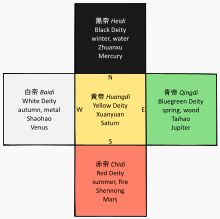
- 三皇 Sānhuáng — Three Patrons (or Augusts) or 三才 Sāncái — Three Potencies; they are the "vertical" manifestation of Heaven spatially corresponding to the Three Realms (三界 Sānjiè), representing the yin and yang and the medium between them, that is the human being:
- 伏羲 Fúxī the patron of heaven (天皇 Tiānhuáng), also called Bāguàzǔshī (八卦祖師 "Venerable Inventor of the Bagua") by the Taoists, is a divine man reputed to have taught to humanity writing, fishing, and hunting.
- 女媧 Nǚwā the patron of earth (地皇 Dehuáng), is a goddess attributed for the creation of mankind and mending the order of the world when it was broken.
- 神農 Shénnóng — Peasant God, the patron of humanity (人皇 Rénhuáng), identified as Yándì (炎帝 "Flame Deity" or "Fiery Deity"), a divine man said to have taught the techniques of farming, herbal medicine and marketing. He is often represented as a human with horns and other features of an ox.[48]
- 五帝 Wǔdì — Five Deities,[13] also Wǔfāng Shàngdì (五方上帝 "Five Manifestations of the Highest Deity"), Wǔfāng Tiānshén (五方天神 "Five Manifestations of the Heavenly God"), Wǔfāngdì (五方帝 "Five Forms Deity"), Wǔtiāndì (五天帝 "Five Heavenly Deities"), Wǔlǎojūn (五老君 "Five Ancient Lords"), Wǔdàoshén (五道神 "Five Ways God(s)"); they are the five main "horizontal" manifestations of Heaven and according with the Three Potencies they have a celestial, a terrestrial and a chthonic form. They correspond to the five phases of creation, the five constellations rotating around the celestial pole and five planets, the five sacred mountains and five directions of space (their terrestrial form), and the five Dragon Gods which represent their mounts, that is to say the material forces they preside over (their chthonic form).[49][50]
- 黃帝 Huángdì — Yellow Emperor or Yellow Deity; or 黃神 Huángshén — Yellow God, also known as Xuānyuán Huángdì (軒轅黃帝 "Yellow Deity of the Chariot Shaft"), is the Zhōngyuèdàdì (中岳大帝 "Great Deity of the Central Peak"): he represents the essence of earth and the Yellow Dragon,[48] and is associated with Saturn.[50] The character 黃 huáng, for "yellow", also means, by homophony and shared etymology with 皇 huáng, "august", "creator" and "radiant", identifying the Yellow Emperor with Shangdi (the "Highest Deity").[51] Huangdi represents the heart of creation, the axis mundi (Kunlun) that is the manifestation of the divine order in physical reality, opening the way to immortality.[48] As the deity of the centre, intersecting the Three Patrons and the Five Deities, in the Shizi he is described as "Yellow Emperor with Four Faces" (黃帝四面 Huángdì Sìmiàn).[52] As a human, he is said to have been the fruit of a virginal birth, as his mother Fubao conceived him as she was aroused, while walking in the country, by a lightning from the Big Dipper (Great Chariot). She delivered her son after twenty-four months on the mount of Shou (Longevity) or mount Xuanyuan (Chariot Shaft), after which he was named.[53] He is reputed to be the founder of the Huaxia civilisation, and the Han Chinese identify themselves as the descendants of Yandi and Huangdi.
- 蒼帝 Cāngdì — Green Deity; or 青帝 Qīngdì — Blue Deity or Bluegreen Deity, the Dōngdì (東帝 "East Deity") or Dōngyuèdàdì (東岳大帝 "Great Deity of the Eastern Peak"): he is Tàihào 太昊, associated with the essence of wood and with Jupiter, and is the god of fertility and spring. The Bluegreen Dragon is both his animal form and constellation.[48][50] His female consort is the goddess of fertility Bixia.
- 黑帝 Hēidì — Black Deity, the Běidì (北帝 "North Deity") or Běiyuèdàdì (北岳大帝 "Great Deity of the Northern Peak"): he is Zhuānxū (顓頊), today frequently worshipped as Xuánwǔ (玄武 "Dark Warrior") or Zhēnwǔ (真武), and is associated with the essence of water and winter, and with Mercury. His animal form is the Black Dragon and his stellar animal is the tortoise-snake.[48][50]
- 赤帝 Chìdì — Red Deity, the Nándì (帝 "South Deity") or Nányuèdàdì (南岳大帝 "Great Deity of the Southern Peak"): he is Shennong (the "Divine Farmer"), the Yandi ("Fiery Deity"), associated with the essence of fire and summer, and with Mars. His animal form is the Red Dragon and his stellar animal is the phoenix. He is the god of agriculture, animal husbandry, medicinal plants and market.[48][50]
- 白帝 Báidì — White Deity, the Xīdì (西帝 "West Deity") or Xīyuèdàdì (西岳大帝 "Great Deity of the Western Peak"): he is Shǎohào (少昊), and is the god of the essence of metal and autumn, associated with Venus. His animal form is the White Dragon and his stellar animal the tiger.[50]
- 三官 Sānguān or 三官大帝 Sānguāndàdì — Three Officials [of Heaven] or Three Officer Great Deities: Yao 堯 the Official of Heaven (Tiānguān 天官), Shun 舜 the Official of Earth (Deguān 地官), and Yu 禹 the Official of Water (Shuǐguān 水官).
In mythology, Huangdi and Yandi fought a battle against each other; and Huang finally defeated Yan with the help of the Dragon (the controller of water, who is Huangdi himself).[54] This myth symbolises the equipoise of yin and yang, here the fire of knowledge (reason and craft) and earthly stability.[54] Yan 炎 is flame, scorching fire, or an excess of it (it is important to note that graphically it is a double 火 huo, "fire").[54] As an excess of fire brings destruction to the earth, it has to be controlled by a ruling principle. Nothing is good in itself, without limits; good outcomes depend on the proportion in the composition of things and their interactions, never on extremes in absolute terms.[54] Huangdi and Yandi are complementary opposites, necessary for the existence of one another, and they are powers that exist together within the human being.
Gods of celestial and terrestrial phenomena
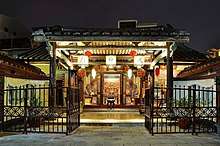
- 龍神 Lóngshén — Dragon Gods, or 龍王 Lóngwáng — Dragon Kings: also Sìhǎi Lóngwáng (四海龍王 "Dragon Kings of the Four Seas"), are gods of watery sources, usually reduced to four, patrons of the Four Seas (sihai 四海) and the four cardinal directions. They are the White Dragon (白龍 Báilóng), the Black Dragon (玄龍 Xuánlóng), the Red Dragon (朱龍 Zhūlóng), and the Bluegreen Dragon (青龍 Qīnglóng). Corresponding with the Five Deities as the chthonic forces that they sublimate (the Dragon Gods are often represented as the "mount" of the Five Deities), they inscribe the land of China into an ideal sacred squared boundary. The fifth dragon, the Yellow Dragon (黃龍 Huánglóng), is the dragon of the centre representing the Yellow God.
- 雹神 Báoshén — Hail God[lower-roman 4]
- 八蜡 Bālà, 蟲神 Chóngshén — Insect God, or 蟲王 Chóngwáng — Insect King: the gods of insects[lower-roman 4]
- 痘神 Dòushén — Smallpox God[lower-roman 4]
- 風神 Fēngshén — Wind God, or 飛帘 Fēi Lián[lower-roman 4]
- 海神 Hǎishén — Sea God, or 海爷 Hǎiyé — Sea Lord
- 河神 Héshén — River God: any watercourse god among which one of the most revered is the god of the Yellow River, 河伯 Hébó — River Lord[lower-roman 4]
- 穀神 Gǔshén — Valley God, in the Daodejing a name used to refer to the Way[55]
- 火神 Huǒshén — Fire God, often personified as Zhùróng (祝融)[lower-roman 4]
- 湖神 Húshén — Lake God
- 金神 Jīnshén — Gold God, often identified as the 秋神 Qiūshén — Autumn God, and personified as Rùshōu (蓐收)
- 井神 Jǐngshén — Waterspring God[55]
- 雷神 Léishén — Thunder God, or 雷公 Léigōng — Thunder Duke;[lower-roman 3] his consort is 電母 Diànmǔ — Lightning Mother
- 木神 Mùshén — Woodland God, usually the same as the 春神 Chūnshén — Spring God, and as Jùmáng (句芒)
- 山神 Shānshén — Mountain God
- 水神 Shuǐshén — Water God
- 土地神 Tǔdìshén — God of the Local Land, or 土神 Tǔshén — Earth God, or 土地公 Tǔdìgōng — Duke of the Local Land:[lower-roman 3] the tutelary deity of any locality whose female counterpart is 后土 Hòutǔ — Queen of the Earth[lower-roman 2]
- 瘟神 Wēnshén — Plague God[lower-roman 4]
- 湘水神 Xiāngshuǐshén — Xiang Waters' Goddesses, are the patrons of the Xiang River
- 雪神 Xuěshén — Snow God
- 雨神 Yǔshén — Rain God[lower-roman 4]
- 羲和 Xīhé the 太陽神 Tàiyángshén — Great Sun Goddess, or 十日之母 Shírìzhīmǔ — Mother of the Ten Suns[lower-roman 2]
- 月神 Yuèshén — Moon Goddesses: 常羲 Chángxī or 十二月之母 Shí'èryuèzhīmǔ — Mother of the Twelve Moons, and 嫦娥 Cháng'é
Gods of human virtues and crafts
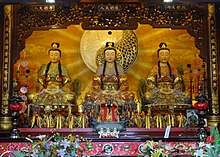
- Civil (wen) and military (wu) deities:
- 文帝 Wéndi — Culture Deity, or 文昌帝 Wénchāngdì — Deity who Makes Culture Thrive, or 文昌王 Wénchāngwáng — King who Makes Culture Thrive: in southern provinces this deity takes the identity of different historical persons while in the north he is more frequently the same as Confucius (Kǒngfūzǐ 孔夫子)
- 魁星 Kuíxīng — Chief Star, another god of culture and literature, but specifically examination, is a personification of the man who awakens to the order of the Great Chariot
- 武帝 Wǔdì — Military Deity: 關帝 Guāndì — Divus Guan, also called 關公 Guāngōng — Duke Guan,[lower-roman 3] and popularly 關羽 Guānyǔ[lower-roman 2]
- 文帝 Wéndi — Culture Deity, or 文昌帝 Wénchāngdì — Deity who Makes Culture Thrive, or 文昌王 Wénchāngwáng — King who Makes Culture Thrive: in southern provinces this deity takes the identity of different historical persons while in the north he is more frequently the same as Confucius (Kǒngfūzǐ 孔夫子)
- 保生大帝 Bǎoshēngdàdì — Great Deity who Protects Life[lower-roman 5]
- 八仙 Bāxiān — Eight Immortals
- 蠶神 Cánshén — Silkworm God, who may be:
- 蠶母 Cánmǔ — Silkworm Mother, also called 蠶姑 Cángū — Silkworm Maiden), who is identified as Léizǔ (嫘祖, the wife of the Yellow Emperor: the invention of sericulture is attributed primarily to her
- 青衣神 Qīngyīshén — Bluegreen-Clad God: his name as a human was 蠶叢 Cáncóng — Silkworm Twig, and he is the first ruler and ancestor of the Shu state, and promoter of sericulture among his people
- 財神 Cáishén — Wealth God[lower-roman 2]
- 倉頡 Cāngjié, the four-eyed inventor of the Chinese characters
- 城隍神 Chénghuángshén — Moat and Walls God, Boundary God: the god of the sacred boundaries of a human agglomeration, he is often personified by founding fathers or noble personalities from each city or town[lower-roman 2]
- 陳靖姑 Chénjìnggū — Old Quiet Lady, also called 臨水夫人 Línshuǐ Fūrén — Waterside Dame[lower-roman 5]
- 車神 Chēshén — Vehicle God[lower-roman 4]
- 二郎神 Èrlángshén — Twice Young God, the god of engineering
- 廣澤尊王 Guǎngzé Zūnwáng — Honorific King of Great Compassion[lower-roman 5]
- 觀音 Guānyīn — She who Hears the Cries of the World, the goddess of mercy[lower-roman 2]
- 黃大仙 Huáng Dàxiān — Great Immortal Huang
- 濟公 Jìgōng — Help Lord
- 酒神 Jiǔshén — Wine God, personified as 儀狄 Yídí[lower-roman 4]
- 九天玄女 Jiǔtiān Xuánnǚ — Mysterious Lady of the Nine Heavens, a disciple of Xiwangmu and initiator of Huangdi
- 龍母 Lóngmǔ — Dragon Mother
- 魯班 Lǔbān, the god of carpentry
- 路神 Lùshén — Road God[lower-roman 4]
- 媽祖 Māzǔ — Ancestral Mother, often entitled the Queen of Heaven[lower-roman 1][lower-roman 6]
- 平安神 Píng'ānshén — Peace God, an embodiment of whom is considered to have been Mao Zedong[57]
- 清水祖師 Qīngshuǐ Zǔshī — Venerable Patriarch of the Clear Stream[lower-roman 5]
- 陶神 Táoshén — Pottery God[lower-roman 4]
- 兔兒神 Tùershén — Leveret God, the god of love among males
- 托塔李天王 Tuōtǎlǐ Tiānwáng — Tower-Wielding Heavenly King, in person Li Jing, who has three sons, the warlike protector deities Jīnzhā (金吒), Mùzhā (木吒) and Nǎzhā (哪吒)
- 五顯 Wǔxiǎn — Five Shining Ones, possibly a popular form of the cosmological Five Deities[lower-roman 5]
- 喜神 Xǐshén — Joy God
- 藥神 Yàoshén — Medicine God, or frequently 藥王 Yàowáng — Medicine King"[lower-roman 4]
- 月下老人 Yuèxià Lǎorén — Old Man Under the Moon, the matchmaker who pairs lovers together
- 獄神 Yùshén — Jail-Purgatory God[lower-roman 4]
- 灶神 Zàoshén — Hearth God, the master of the household deities including: the Bed God (床神 Chuángshén), the Gate Gods (門神 Ménshén) and the Toilet God (廁神 Cèshén)
- 三星 Sānxīng — Three Stars, a cluster of three astral gods of well being:
Gods of animal and vegetal life
- 花神 Huāshén — Flower Goddess
- 狐神 Húshén — Fox God(dess), or 狐仙 Húxiān — Fox Immortal", also called 狐仙娘娘 Húxiān Niángniáng — Fox Immortal Lady"[lower-roman 7]
- Two other great fox deities, peculiar to northeast China, are the Great Lord of the Three Foxes (胡三太爷 Húsān Tàiyé) and the Great Lady of the Three Foxes (胡三太奶 Húsān Tàinǎi) representing the yin and yang[lower-roman 7]
- 馬神 Mǎshén — Horse God, or Mǎwáng 马王 — Horse King[lower-roman 4]
- 牛神 Niúshén — Cattle God or Ox God, also called 牛王 Niúwáng — Cattle King[lower-roman 4]
- 狼神 Lángshén — Wolf God[lower-roman 4]
- 樹神 Shùshén — Tree God(s)
- 五谷神 Wǔgǔshén — Five Cereals God,[lower-roman 4] another name of Shennong
- 猿神 Yuánshén — Monkey God, or 猿王 Yuánwáng — Monkey King, who is identified as Sūn Wùkōng (孙悟空)
- 芝蔴神 Zhīmáshén — Sesame God[lower-roman 4]
Bixia mother goddess worship
.jpg)
The worship of mother goddesses for the cultivation of offspring is present all over China, but predominantly in northern provinces. There are nine main goddesses, and all of them tend to be considered as manifestations or attendant forces of a singular goddess identified variously as the Lady of the Blue Dawn (Bìxiá Yuánjūn 碧霞元君, also known as the Tiānxiān Niángniáng 天仙娘娘, "Heavenly Immortal Lady", or Tàishān Niángniáng 泰山娘娘, "Lady of Mount Tai",[lower-roman 8] or also Jiǔtiān Shèngmǔ 九天聖母,[58] "Holy Mother of the Nine Skies"[lower-roman 9])[59]:149–150 or Houtu, the goddess of the earth.[60] Bixia herself is identified by Taoists as the more ancient goddess Xiwangmu,[61] The general Chinese term for "goddess" is 女神 nǚshén, and goddesses may receive many qualifying titles including mǔ (母 "mother"), lǎomǔ (老母 "old mother"), shèngmǔ (聖母 "holy mother"), niángniáng (娘娘 "lady"), nǎinai (奶奶 "granny").
The additional eight main goddesses of fertility, reproduction and growth are:[59]:149–150; 191, note 18
- 瘢疹娘娘 Bānzhěn Niángniáng, the goddess who protects children from illness;
- 催生娘娘 Cuīshēng Niángniáng, the goddess who gives swift childbirth and protects midwives;
- 奶母娘娘 Nǎimǔ Niángniáng, the goddess who presides over maternal milk and protects nursing;
- 培姑娘娘 Péigū Niángniáng, the goddess who cultivate children;
- 培養娘娘 Péiyǎng Niángniáng, the goddess who protects the upbringing of children;
- 送子娘娘 Sòngzi Niángniáng or 子孫娘娘 Zǐsūn Niángniáng, the goddess who presides over offspring;
- 眼光娘娘 Yǎnguāng Niángniáng, the goddess who protects eyesight;
- 引蒙娘娘 Yǐnméng Niángniáng, the goddess who guides young children.
Altars of goddess worship are usually arranged with Bixia at the center and two goddesses at her sides, most frequently the Lady of Eyesight and the Lady of Offspring.[59]:149–150; 191, note 18 A different figure but with the same astral connections as Bixia is the Goddess of the Seven Stars (七星娘娘 Qīxīng Niángniáng).[lower-roman 10] There is also the cluster of the Holy Mothers of the Three Skies (三霄聖母 Sānxiāo Shèngmǔ; or 三霄娘娘 Sānxiāo Niángniáng, "Ladies of the Three Stars"), composed of Yunxiao Guniang, Qiongxiao Guniang and Bixiao Guniang.[62] The cult of Chenjinggu present in southeast China is identified by some scholars as an emanation of the northern cult of Bixia.[63]
Other goddesses worshipped in China include Cánmǔ[lower-roman 11] (蠶母 Silkworm Mother) or Cángū (蠶姑 Silkworm Maiden),[60] identified with Léizǔ (嫘祖, the wife of the Yellow Emperor), Mágū (麻姑 "Hemp Maiden"), Sǎoqīng Niángniáng (掃清娘娘 Goddess who Sweeps Clean),[lower-roman 12][65] Sānzhōu Niángniáng (三洲娘娘 Goddess of the Three Isles),[65] and Wusheng Laomu. Mother goddess is central in the theology of many folk religious sects.[60]
Gods of northeast China
Northeast China has clusters of deities which are peculiar to the area, deriving from the Manchu and broader Tungusic substratum of the local population. Animal deities related to shamanic practices are characteristic of the area and reflect wider Chinese cosmology. Besides the aforementioned Fox Gods (狐仙 Húxiān), they include:
- 黃仙 Huángxiān — Yellow Immortal, the Weasel God
- 蛇仙 Shéxiān — Snake Immortal, also variously called 柳仙 Liǔxiān — Immortal Liu, or 常仙 Chángxiān — Viper Immortal, or also 蟒仙 Mǎngxiān — Python or Boa Immortal
- 白仙 Báixiān — White Immortal, the Hedgehog God
- 黑仙 Hēixiān — Black Immortal, who may be the 烏鴉仙 Wūyāxiān — Crow Immortal, or the 灰仙 Huīxiān — Rat Immortal, with the latter considered a misinterpretation of the former
Gods of Indian origin
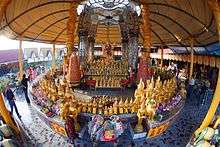
Gods who have been adopted into Chinese religion but who have their origins in the Indian subcontinent or Hinduism:
- 觀音 Guānyīn — "She who Hears the Cries of the World", a Chinese goddess of mercy modeled after the bodhisattva Avalokiteśvara
- 四面神 Sìmiànshén — "Four-Faced God", but also a metaphor for "Ubiquitous God": The recent cult has its origin in the Thai transmission of the Hindu god Brahma, but it is important to note that it is also an epithet of the indigenous Chinese god Huangdi who, as the deity of the centre of the cosmos, is described in the Shizi as "Yellow Emperor with Four Faces" (黃帝四面 Huángdì Sìmiàn).[52]
- 象頭神 Xiàngtóushén — "Elephant-Head God", is the Indian god Ganesha[66]
Gods of northern people
- 格薩爾 Gésàěr or 格斯爾 Gésīěr (+ 王 wáng or + 神 shén) — "King Gesar" or "God Gesar", an interethnic culture hero of a namesake epic poem, worshipped by Tibetans, Mongols, Han Chinese and other ethnic groups. He derives from Divus Caesar of ancient Rome through a cultural transmission from the peoples of Central Asia.
- Genghis Khan (成吉思汗 Chéngjísīhán), worshipped by Mongols and Chinese under a variety of divinity titles including 聖武皇帝 Shèngwǔ Huángdì — "Holy Military Sovereign Deity", 法天啓運 Fǎtiān Qǐyùn "Starter of the Transmission of the Law of Heaven", and 太祖 Tàizǔ — "Great Ancestor" (of the Yuan and the Mongols).
See also
- Chinese folk religion
- Chinese temple
- Shen
- Xian
- Zhenren
Notes
- The term "thearch" is from Greek theos ("deity"), with arche ("principle", "origin"), thus meaning "divine principle", "divine origin". In sinology it has been used to designate the incarnated gods who, according to Chinese tradition, sustain the world order and originated China. It is one of the alternating translations of 帝 dì, together with "emperor" and "god".[12]
- Whether centred in the changeful precessional north celestial pole or in the fixed north ecliptic pole, the spinning constellations draw the wàn 卍 symbol around the centre.
- Notes about the deities and their names
- The honorific Tiānhòu (天后 "Queen of Heaven") is used for many goddesses, but most frequently Mazu and Doumu.
- The cult of this deity is historically exercised all over China.[41]
- About the use of the title "duke": the term is from Latin dux, and describes a phenomenon or person who "conducts", "leads", the divine inspiration.
- The cult of this deity is historically exercised in northern China.[46] It is important to note that many cults of northern deities were transplanted also in southern big cities like Hong Kong and Macau, and also in Taiwan, with the political changes and migrations of the 19th and 20th centuries.
- The cult of this deity is historically exercised in southeastern China.[41]
- The cult of Mazu has its origin in Fujian, but it has expanded throughout southern China and in many northern provinces, chiefly in localities along the coast, as well as among expatriate Chinese communities.[56]
- The cult of fox deities is characteristic of northeastern China's folk religion, with influences reaching as far south as Hebei and Shandong.
- As the Lady of Mount Tai, Bixia is regarded as the female counterpart of Dongyuedadi, the "Great Deity of the Eastern Peak" (Mount Tai).
- The "Nine Skies" (九天 Jiǔtiān) are the nine stars (seven stars with the addition of two invisibile ones, according to the Chinese tradition) of the Big Dipper or Great Chariot. Thus, Bixia and her nine attendants or manifestations are at the same time a metaphorical representation of living matter or earth, and of the source of all being which is more abstractly represented by major axial gods of Chinese religion such as Doumu.
- Qixing Niangniang ("Lady of the Seven Stars") is a goddess that represents the seven visible stars of the Big Dipper or Great Chariot.
- The cult of Canmu is related to that of Houtu ("Queen of Earth") and to that of the Sanxiao ("Three Skies") goddesses.[64]
- Saoqing Niangniang ("Lady who Sweeps Clean") is the goddess who ensures good weather conditions "sweeping away" clouds and storms.
References
Citations
- Lü & Gong (2014), p. 71.
- Didier (2009), passim.
- Zhong (2014), pp. 76–77.
- Zhong (2014), p. 84, note 282.
- 民間信仰的神明概念 [Hierarchic organisation of the spiritual world]. web.sgjh.tn.edu.tw.
- Zhong (2014), p. 98 ff.
- Zhao (2012), p. 45.
- Zhong (2014), p. 202.
- Zhong (2014), p. 64.
- Zhong (2014), pp. 173–174.
- Feuchtwang (2016), p. 147.
- Pregadio (2013), p. 504, vol. 1, A-L: "Each sector of heaven (the four points of the compass and the center) was personified by a di 帝 (a term which indicates not only an emperor but also an ancestral "thearch" and "god")".
- Medhurst (1847), p. 260.
- Zhao (2012), p. 51.
- Lü & Gong (2014), p. 63.
- Didier (2009), p. 256, Vol. III.
- Mair, Victor H. (2011). "Religious Formations and Intercultural Contacts in Early China". In Krech, Volkhard; Steinicke, Marion (eds.). Dynamics in the History of Religions between Asia and Europe: Encounters, Notions, and Comparative Perspectives. Leiden: Brill. pp. 85–110. ISBN 9004225358. pp. 97–98, note 26.
- Didier (2009), p. 257, Vol. I.
- Reiter, Florian C. (2007). Purposes, Means and Convictions in Daoism: A Berlin Symposium. Otto Harrassowitz Verlag. ISBN 3447055138. p. 190.
- Milburn, Olivia (2016). The Spring and Autumn Annals of Master Yan. Sinica Leidensia. BRILL. ISBN 9004309667. p. 343, note 17.
- Assasi, Reza (2013). "Swastika: The Forgotten Constellation Representing the Chariot of Mithras". Anthropological Notebooks (Supplement: Šprajc, Ivan; Pehani, Peter, eds. Ancient Cosmologies and Modern Prophets: Proceedings of the 20th Conference of the European Society for Astronomy in Culture). Ljubljana: Slovene Anthropological Society. XIX (2). ISSN 1408-032X.
- Adler (2011), pp. 4-5.
- Cai (2004), p. 314.
- Adler (2011), p. 5.
- Chang (2000).
- Lü & Gong (2014), pp. 63-67.
- Lü & Gong (2014), p. 64.
- Zhou (2005).
- Zhong (2014), p. 66, note 224.
- Lagerwey & Kalinowski (2008), p. 240.
- Lü & Gong (2014), p. 66.
- Lü & Gong (2014), p. 65.
- Lagerwey & Kalinowski (2008), p. 981.
- Yao (2010), p. 159.
- Yao (2010), p. 161.
- Lagerwey & Kalinowski (2008), p. 984.
- Pregadio (2013), p. 1197.
- Cheu, Hock Tong (1988). The Nine Emperor Gods: A Study of Chinese Spirit-medium Cults. Time Books International. ISBN 9971653850. p. 19.
- DeBernardi, Jean (2007). "Commodifying Blessings: Celebrating the Double-Yang Festival in Penang, Malaysia and Wudang Mountain, China". In Kitiarsa, Pattana (ed.). Religious Commodifications in Asia: Marketing Gods. Routledge. ISBN 113407445X.
- Pregadio (2013), pp. 76, 1193.
- Overmyer (2009), p. 148.
- Lagerwey & Kalinowski (2008), p. 983.
- Max Dashu (2010). "Xiwangmu: The Shamanic Great Goddess of China". Academia.edu.
- Fowler (2005), pp. 206-207.
- Lagerwey & Kalinowski (2008), p. 512.
- Overmyer (2009), passim chapter 5: "Gods and Temples".
- Sun & Kistemaker (1997), p. 121.
- Fowler (2005), pp. 200-201.
- Little & Eichman (2000), p. 250. It describes a Ming dynasty painting representing (among other figures) the Wudi: "In the foreground are the gods of the Five Directions, dressed as emperors of high antiquity, holding tablets of rank in front of them. [...] These gods are significant because they reflect the cosmic structure of the world, in which yin, yang and the Five Phases (Elements) are in balance. They predate religious Taoism, and may have originated as chthonic gods of the Neolithic period. Governing all directions (east, south, west, north and center), they correspond not only to the Five Elements, but to the seasons, the Five Sacred Peaks, the Five Planets, and zodiac symbols as well. [...]".
- Sun & Kistemaker (1997), pp. 120-123.
- Pregadio (2013), pp. 504-505.
- Sun & Kistemaker (1997), p. 120.
- Bonnefoy, Yves (1993). Asian Mythologies. University of Chicago Press. ISBN 0226064565. p. 246.
- Lee, Keekok (2008). Warp and Weft, Chinese Language and Culture. Strategic Book Publishing. ISBN 1606932470. pp. 156-157
- Yao (2010), p. 202.
- Overmyer (2009), p. 144.
- Tvetene Malme, Erik (Spring 2014). 平安神 Mao Zedong as a Deity (PDF). University of Oslo's Department of Culture Studies and Oriental Languages.
- Overmyer (2009), p. 137.
- Barrott Wicks, Ann Elizabeth (2002). Children in Chinese Art. University of Hawaii Press. ISBN 0824823591.
- Jones (2013), pp. 166-167.
- Komjathy, Louis (2013). "Daoist deities and pantheons". The Daoist Tradition: An Introduction. Bloomsbury Publishing. ISBN 1441196455.
- Overmyer (2009), p. 135.
- Hackin, J. (1932). Asiatic Mythology: A Detailed Description and Explanation of the Mythologies of All the Great Nations of Asia. Asian Educational Services. pp. 349-350.
- Jones (2013), p. 167.
- Chamberlain (2009), p. 235.
- Martin-Dubost, Paul (1997). Gaņeśa: The Enchanter of the Three Worlds. Mumbai: Project for Indian Cultural Studies. ISBN 8190018434. p. 311.
Sources
- Adler, Joseph A. (2011). The Heritage of Non-Theistic Belief in China (PDF). (Conference paper) Toward a Reasonable World: The Heritage of Western Humanism, Skepticism, and Freethought. San Diego, CA.CS1 maint: ref=harv (link)
- Cai, Zongqi (2004). Chinese Aesthetics: Ordering of Literature, the Arts, and the Universe in the Six Dynasties. University of Hawaii Press. ISBN 0824827910.CS1 maint: ref=harv (link)
- Chamberlain, Jonathan (2009). Chinese Gods : An Introduction to Chinese Folk Religion. Hong Kong: Blacksmith Books. ISBN 9789881774217.CS1 maint: ref=harv (link)
- Chang, Ruth H. (2000). "Understanding Di and Tian: Deity and Heaven from Shang to Tang Dynasties" (PDF). Sino-Platonic Papers. Victor H. Mair (108). ISSN 2157-9679.CS1 maint: ref=harv (link)
- Didier, John C. (2009). "In and Outside the Square: The Sky and the Power of Belief in Ancient China and the World, c. 4500 BC – AD 200". Sino-Platonic Papers. Victor H. Mair (192).CS1 maint: ref=harv (link) Volume I: The Ancient Eurasian World and the Celestial Pivot, Volume II: Representations and Identities of High Powers in Neolithic and Bronze China, Volume III: Terrestrial and Celestial Transformations in Zhou and Early-Imperial China.
- Feuchtwang, Stephan (2016), "Chinese religions", in Woodhead, Linda; Kawanami, Hiroko; Partridge, Christopher H. (eds.), Religions in the Modern World: Traditions and Transformations (3nd ed.), London: Routledge, pp. 143–172, ISBN 1317439600CS1 maint: ref=harv (link)
- Fowler, Jeanine D. (2005). An Introduction to the Philosophy and Religion of Taoism: Pathways to Immortality. Sussex Academic Press. ISBN 1845190866.CS1 maint: ref=harv (link)
- Jones, Stephen (2013). In Search of the Folk Daoists of North China. Ashgate Publishing. ISBN 1409481301.CS1 maint: ref=harv (link)
- Lagerwey, John; Kalinowski, Marc, eds. (2008). Early Chinese Religion: Part One: Shang Through Han (1250 BC-220 AD). Early Chinese Religion. Leiden: Brill. ISBN 9004168354.CS1 maint: ref=harv (link)
- Little, Stephen; Eichman, Shawn (2000). Taoism and the Arts of China. University of California Press. ISBN 0520227859.CS1 maint: ref=harv (link)
- Lü, Daji; Gong, Xuezeng (2014). Marxism and Religion. Religious Studies in Contemporary China. Brill. ISBN 9047428021.CS1 maint: ref=harv (link)
- Medhurst, Walter H. (1847). A Dissertation on the Theology of the Chinese, with a View to the Elucidation of the Most Appropriate Term for Expressing the Deity, in the Chinese Language. Mission Press.CS1 maint: ref=harv (link) Original preserved at The British Library. Digitalised in 2014.
- Overmyer, Daniel L. (2009). Local Religion in North China in the Twentieth Century the Structure and Organization of Community Rituals and Beliefs (PDF). Leiden; Boston: Brill. ISBN 9789047429364. Archived from the original (PDF) on 2015-06-16. Retrieved 2016-07-22.CS1 maint: ref=harv (link)
- Pregadio, Fabrizio (2013). The Encyclopedia of Taoism. Routledge. ISBN 1135796343.CS1 maint: ref=harv (link) Two volumes: 1) A-L; 2) L-Z.
- Sun, Xiaochun; Kistemaker, Jacob (1997). The Chinese Sky During the Han: Constellating Stars and Society. Brill. ISBN 9004107371.CS1 maint: ref=harv (link)
- Yao, Xinzhong (2010). Chinese Religion: A Contextual Approach. London: A&C Black. ISBN 9781847064752.CS1 maint: ref=harv (link)
- Zhong, Xinzi (2014). A Reconstruction of Zhū Xī's Religious Philosophy Inspired by Leibniz: The Natural Theology of Heaven (PDF) (Thesis). Open Access Theses and Dissertations. Hong Kong Baptist University Institutional Repository.CS1 maint: ref=harv (link)
- Zhao, Dunhua (2012), "The Chinese Path to Polytheism", in Wang, Robin R. (ed.), Chinese Philosophy in an Era of Globalization, SUNY Press, ISBN 0791485501CS1 maint: ref=harv (link)
- Zhou, Jixu (2005). "Old Chinese "*tees" and Proto-Indo-European "*deus": Similarity in Religious Ideas and a Common Source in Linguistics" (PDF). Sino-Platonic Papers. Victor H. Mair (167).CS1 maint: ref=harv (link)
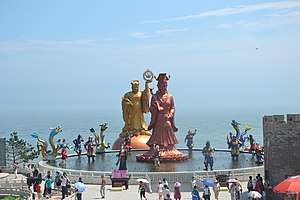

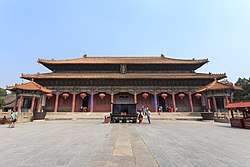
_in_Osaka.jpg)
